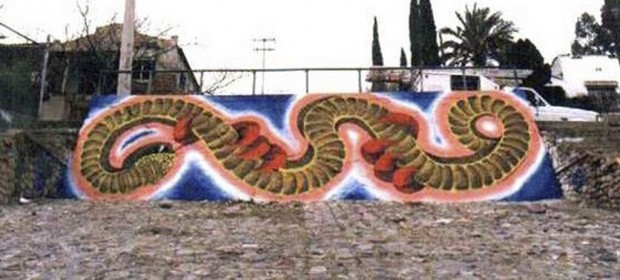Despite the massive amounts of money poured into the graffiti abatement industry and public works agencies, abatement workers still appear to have serious challenges differentiating between legal (and historic) murals and illegal vandalism. The workers in Nogales recently painted out a 16-year-old mural by well-known local artist Alberto Morackis. Abatement, like many city jobs, takes workers all over the city, yet the buffers still managed to be unaware of that they were painting over a landmark in their community.
This brings up several important questions regarding the abatement field. What criteria are being used to determine whether or not a mural is legal or illegal? What training is given to abatement workers when they are hired? What are the hiring requirements? The Nogales incident is hardly an isolated instance. Public works crews and the privatized counterparts routinely mistake professional murals. (Stay tuned for a similar instance in Evanston, Illinois tomorrow.)
The question remains, what can be done? CRP has several recommendations for cities and counties that want to protect their artwork, as well as some reminders for the artists. First, CRP has developed the mural registry initiative to serve as pro-active database that public works officials can refer to. However, because the registry is voluntary, city abatement workers should also be trained to differentiate between vandalism and legal art. Another recommendation is to do some basic investigating. Ask the residents or a neighbor for starters. Public works officials are notorious for a “paint now, ask questions later” approach. To prevent the city from being liable for vandalism, we recommend that city officials instruct their works not to paint over anything that is questionable until all of the appropriate questions have been answered.
For the artists, if your mural is destroyed, you have a right to sue the painter under the VARA act (in the US). While it is commendable that Nogales officials took immediate responsibility and the mayor supports the local collective repainting the piece, these statement need to be accompanied by complete financial responsibility from the city of Nogales. That does not mean only purchasing supplies for the mural but full compensation including room and board, per diem and stipends for all of the artists. These are standard costs for artwork. If the cities like Oakland and Los Angeles can attempt to recoup the cost of the benefits paid to buffers, attorneys fees, and the costs of their detective in their fines for illegal vandalism, then artists needs to assert similar rights when our work is destroyed.

The graffiti-abatement staff in Nogales, Sonora, works fast – apparently a little too fast.
In recent days, it responded to a citizen complaint about graffiti in an area a few blocks south of the border downtown, but they ended up painting over a 16-year-old mural by well-known local artist Alberto Morackis.
Morackis, who died in 2008, painted the mural, known informally as “La Serpiente,” in 1996. It was painted on a wall on a steep hillside about three blocks south of the border, a block west of the main drag, Avenida Obregón.
Morackis was a pioneering artist in Nogales, Sonora, having started the Taller Yonke (Junk Workshop) with Guadalupe Serrano.
The two became known for putting up artwork along the border fence, and they displayed some of this work at the University of Arizona.
“Alberto was really the force behind the mural movement in Nogales, Sonora,” said UA art professor Alfred Quiroz, who collaborated with Morackis in a 2007 project along the border fence.
Ignacio Riestra, director of Nogales’ “Urban Image” office, told the local newspaper El Diario de Sonora that he asks his employees to respond to citizen complaints within three hours.
“The truth is it was a mistake, from us trying to respond to the community,” Riestra told El Diario.
It’s unclear whether the complaint was about the mural itself or something nearby.
Serrano said the mural, formally titled “México Opuesto” (Mexico in Opposition), showed the snake in the claws of an eagle featured in Mexico’s national symbol. But the snake is seen from below, and only the claws of the eagle are visible, Serrano said.
The director of Nogales’ art museum, Juan Amparano Gámez, told El Imparcial newspaper, “It’s a piece that screams of identity, justice, democracy and many other things that are always in play in the identity of the U.S. border area.”
Members of the Taller Yonke pledged to repaint the mural, and Mayor Ramón Guzmán said he supports the effort.
